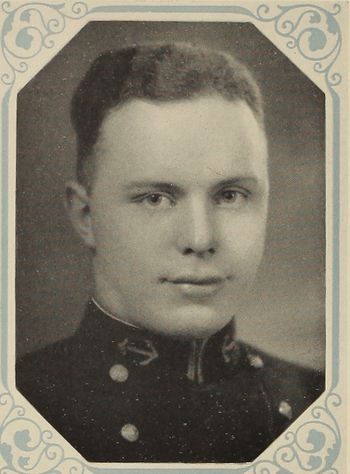HENRY E. BROSSY, LCDR, USN
Henry Brossy '31
Lucky Bag
From the 1931 Lucky Bag:
Henry Earl Brossy
Brooklyn, New York
"Hank"
With a flair for exactness and precision—cultivated by a few years at Brooklyn Tech—Hank came to Annapolis, where he found no special difficulties. While the rest of us were struggling with our ups and downs, Hank kept on as usual, and his steadying influence will not soon be forgotten.
Who hasn't along towards the end of the term, or just before Christmas leave, wished he could transfer a few points of velvet from one subject to another? Brossy partly solved the problem by overworking his steam kit. Not being content with usually accepted limitations of that puzzle box, he made a name for himself by formulating and putting into practice some mighty and unique usages.
By the end of Youngster Year Hank has made a good start towards a record in hop-attendance, but he dropped far behind during second-class summer. The cause of his abrupt change was unknown for a time, as he gave no convincing reason. We soon found the cause—he had discovered that the creeks would float a canoe.
Track 4; Reception Committee 3, 2, 1; Boxing 4, 3, 2, 1; Boxing Manager 1; 2 P. O.

Henry Earl Brossy
Brooklyn, New York
"Hank"
With a flair for exactness and precision—cultivated by a few years at Brooklyn Tech—Hank came to Annapolis, where he found no special difficulties. While the rest of us were struggling with our ups and downs, Hank kept on as usual, and his steadying influence will not soon be forgotten.
Who hasn't along towards the end of the term, or just before Christmas leave, wished he could transfer a few points of velvet from one subject to another? Brossy partly solved the problem by overworking his steam kit. Not being content with usually accepted limitations of that puzzle box, he made a name for himself by formulating and putting into practice some mighty and unique usages.
By the end of Youngster Year Hank has made a good start towards a record in hop-attendance, but he dropped far behind during second-class summer. The cause of his abrupt change was unknown for a time, as he gave no convincing reason. We soon found the cause—he had discovered that the creeks would float a canoe.
Track 4; Reception Committee 3, 2, 1; Boxing 4, 3, 2, 1; Boxing Manager 1; 2 P. O.
Loss
Henry was lost when USS Amberjack (SS 219) was sunk by a patrol craft on February 16, 1943 near Rabaul. He was the boat's executive officer.
Other Information
From researcher Kathy Franz:
Per The Chat newspaper on April 16, 1927:
Henry was one of six Brooklyn boys who were undergoing special instructions at the Navy’s Preparatory school at Hampton Roads, Virginia. “This school is conducted for the purpose of training young men already in the ranks for the regular Government competitive examinations to fill the one hundred annual appointments to the U. S. Naval Academy . . .”
Henry passed the examinations, and The Standard newspaper reported on August 11: The embryo admiral is well remembered by his schoolmates at Public School 45. After completing the grammar school course, he entered Brooklyn Tech High, making an enviable record there. He was graduated in the class of 1925. Having an urgent desire for a naval career he determined to enlist and work his way up to a commission.
He enlisted at the local recruiting station about a year ago and determined to win one of the coveted hundred appointments a year for the Naval Academy for which the enlisted personnel of the navy are eligible. The official report just received indicates how successful he has been. . . .
In a personal letter to Commander Newton, Brossy goes on to tell how he received every encouragement and actual aid from his superior officers while at the Training Station and how he was allowed plenty of time to study. He further states in his letter, “I think if the advantages offered in the navy were more generally known by students of the various high schools, your recruiting station would be swamped with applicants.”
Brossy’s success reflects great credit not only on himself but also on his teachers and the standards of education of the Brooklyn schools.
On January 5, 1935, Henry sailed for Honolulu. Henry married Rhae Earle Hawes of San Diego on June 8, 1936, in Honolulu at the home of Lt. and Mrs. Charles Ostrom '30.
Their son Eric Earle was born January 3, 1939. He later graduated from Coronado High School and received a degree in marine engineering from the California Maritime Academy. He entered the Naval Reserve in 1963 and died in a traffic accident in December, 1968. He was then a Lt. Commander of the USNR who had served in Vietnam as adviser to the Vietnamese Naval Coastal Group 44.
Henry's father and older brother were both named Hugh; mother Mary. Brother Jacob Frees (his mother’s maiden name) was born in 1912. In 1910, Henry’s father was a drug company salesman. He died in June, 1924, and was buried in the Evergreen Cemetery. His mother remarried Coleman M. Gray in 1948, and she died in April, 1957.
His wife was listed as next of kin.
The "Register of Commissioned and Warrant Officers of the United States Navy and Marine Corps" was published annually from 1815 through at least the 1970s; it provided rank, command or station, and occasionally billet until the beginning of World War II when command/station was no longer included. Scanned copies were reviewed and data entered from the mid-1840s through 1922, when more-frequent Navy Directories were available.
The Navy Directory was a publication that provided information on the command, billet, and rank of every active and retired naval officer. Single editions have been found online from January 1915 and March 1918, and then from three to six editions per year from 1923 through 1940; the final edition is from April 1941.
The entries in both series of documents are sometimes cryptic and confusing. They are often inconsistent, even within an edition, with the name of commands; this is especially true for aviation squadrons in the 1920s and early 1930s.
Alumni listed at the same command may or may not have had significant interactions; they could have shared a stateroom or workspace, stood many hours of watch together, or, especially at the larger commands, they might not have known each other at all. The information provides the opportunity to draw connections that are otherwise invisible, though, and gives a fuller view of the professional experiences of these alumni in Memorial Hall.
July 1931
October 1931
January 1932
April 1932
October 1932
January 1933
April 1933
July 1933
LTjg William Pennewill '29 (Scouting Plane Squadron (VS) 10S)
ENS Augustus Alston, Jr. '31 (Cruiser Division 5)
October 1933
April 1934
July 1934
October 1934
January 1935
April 1935
October 1935
January 1937
April 1937
September 1937
LT Robert Bedilion '22
LT William Hobby, Jr. '23
LT Richard Baron '24
LT Richard Gingras '25
LT Harold Pound '25
LT William Graham, Jr. '25
LT Andrew Harris '25
LT Ralph Hickox '27
LTjg John Bermingham '29
January 1938
LT Robert Bedilion '22
LT William Hobby, Jr. '23
LT Richard Baron '24
LT Richard Gingras '25
LT Harold Pound '25
LT William Graham, Jr. '25
LT Andrew Harris '25
LT Ralph Hickox '27
LT John Bermingham '29
July 1938
LT William Hobby, Jr. '23
LT Richard Baron '24
LT Harold Pound '25
LT William Graham, Jr. '25
LT Andrew Harris '25
LT Hilan Ebert '26
LT John Bermingham '29
LT Egbert Roth '29
LT Victor Gaulin '30
LTjg Russell Ross '30
LT John Bisson '30
January 1939
LCDR Robert Bedilion '22
LCDR William Hobby, Jr. '23
LT Richard Baron '24
LT Harold Pound '25
LT William Graham, Jr. '25
LT Andrew Harris '25
LT Hilan Ebert '26
LT John Bermingham '29
LT Egbert Roth '29
LT Victor Gaulin '30
LT Russell Ross '30
October 1939
June 1940
November 1940
April 1941

The "category" links below lead to lists of related Honorees; use them to explore further the service and sacrifice of alumni in Memorial Hall.